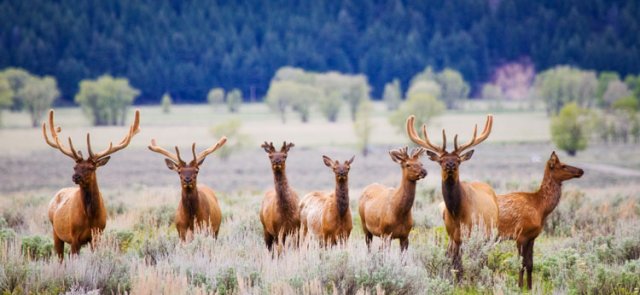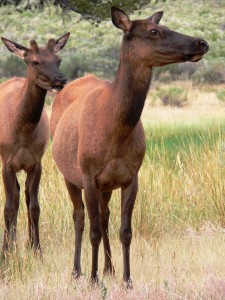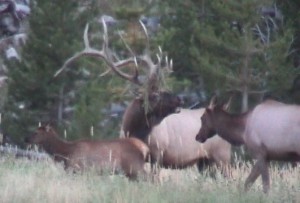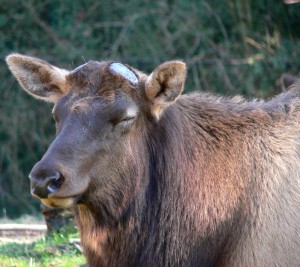The Life of a Bull Elk

In early summer, around the first of June, cow elk give birth. Each cow typically has a single calf, which can stand on wobbly legs by the time it is 20 minutes old. A young bull will stay with the herd in which he was born until his second autumn.  By then, he will have grown his first set of antlers, spindly spikes which may be a foot and a half long, or just small 6 inch protrusions. Hunters often refer to spikes as “Martians” because of their goofy look. Spikes usually get run off by bigger bulls in the fall because their antlers mark them as rivals. Often spikes hang out together, lingering on the fringe of the herd. They are quite easily called in by bowhunters because they are not used to being on their own. Usually they are lonely and curious.
By then, he will have grown his first set of antlers, spindly spikes which may be a foot and a half long, or just small 6 inch protrusions. Hunters often refer to spikes as “Martians” because of their goofy look. Spikes usually get run off by bigger bulls in the fall because their antlers mark them as rivals. Often spikes hang out together, lingering on the fringe of the herd. They are quite easily called in by bowhunters because they are not used to being on their own. Usually they are lonely and curious.
By the third year of a bull’s life, he almost exclusively stays with other bulls, summering and wintering in small groups. Now these bulls start establishing a hierarchy by pushing and shoving during sparring matches. It is here that he learns to keep a distance from larger and stronger bulls, but establishes his own dominance over the weaker ones. His antlers now could sport 3 to 5 points. He is now sexually mature, but it may be several years before he breeds, depending on the bull/cow ratio. Again, once breeding season begins, he is often run off by more mature bulls. Instinctively he begins to bugle, but more often than not still lingers on the fringes of the herd, sparring with bulls his own size, or beating up small saplings with his antlers.
Still in a bachelor herd throughout the winter, a bull continues the pushing and shoving matches until late March or April, when he sheds his antlers. This is a critical survival time. Harsh winter conditions have usually taken 20-30% of a bull’s weight, and many times predators will smell the fresh blood from the antler shedding process and focus their attention on those bulls.
 Years 4 to 6 are when a bull continues to mature physically and also gain breeding status. Having survived several hunting seasons and winters, as well as predators, he is smarter and tougher. Now starting with the fall rut, there are noticeable, physical changes to his body. His neck and shoulder hump may grow to twice the normal size and the neck hair darkens and gets longer. Antlers get polished more and this marks the time when a bull begins serious fighting for the right to breed. He learns to exaggerate his size by every means possible to intimidate other bulls and also to attract cows. His winter coat gets lighter with age.
Years 4 to 6 are when a bull continues to mature physically and also gain breeding status. Having survived several hunting seasons and winters, as well as predators, he is smarter and tougher. Now starting with the fall rut, there are noticeable, physical changes to his body. His neck and shoulder hump may grow to twice the normal size and the neck hair darkens and gets longer. Antlers get polished more and this marks the time when a bull begins serious fighting for the right to breed. He learns to exaggerate his size by every means possible to intimidate other bulls and also to attract cows. His winter coat gets lighter with age.
Prime years typically are 6 to 9 years old. A bull this age is usually dominant and will have his own harem during breeding season. Now, he is the one that violently protects his herd. His antlers carry more mass and he walks with a swagger, like it’s an effort to carry those massive antlers around.
 If a bull survives beyond those prime years, his teeth may begin to wear down and can no longer provide him with enough nutrition for breeding and survival. He will be replaced by younger, stronger bulls and sometimes may remain completely solitary throughout the rutting phase. Being older and mostly solitary makes him easier prey for predators.
If a bull survives beyond those prime years, his teeth may begin to wear down and can no longer provide him with enough nutrition for breeding and survival. He will be replaced by younger, stronger bulls and sometimes may remain completely solitary throughout the rutting phase. Being older and mostly solitary makes him easier prey for predators.
Bull elk live a tough life and any hunter is fortunate to take a bull in the prime years of his life.
